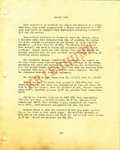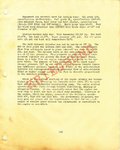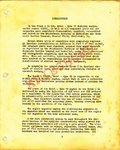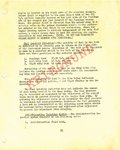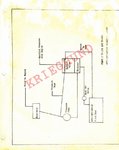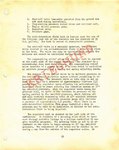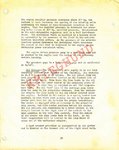Navigation
Install the app
How to install the app on iOS
Follow along with the video below to see how to install our site as a web app on your home screen.
Note: This feature may not be available in some browsers.
More options
You are using an out of date browser. It may not display this or other websites correctly.
You should upgrade or use an alternative browser.
You should upgrade or use an alternative browser.
Nakajama HA-45 Hamore engine
- Thread starter Nikademus
- Start date
Ad: This forum contains affiliate links to products on Amazon and eBay. More information in Terms and rules
More options
Who Replied?Gentlemen: was the WER achieved by ADI system?
Homare easily beats 2-stage B series R-2800, on far smaller displacement
Those power figures are most likely metric. WWII Aircraft Performance has some ATIG reports one Japanese engines. In these reports it's stated that ADI was automatically engaged above 80% normal rated power (maximum continuous power). This would explain why MAP values for the HA-45 seem low.
Achieving high power from a small engine is easy. Achieving high power from a small engine with acceptable reliability and durability is much harder. The HA-45 would neve have passed The US 150 hour Type Test or the 7-1/2 WER Test at anywhere near these ratings.
I believe these are the actual power measures taken durning the engine tests after overhaul. Unfortunately we don't have the engine run charts but the documents references them so I believe these numbers are based on engine test stand figures. Also included is a description of the function of the ADI system. Enjoy
Attachments
Again, many thanks for the stuff, krieghund 
The B series R-2800 were to capable up to 2700 rpm, C series up to 2800. Homare, as we can read here, up to 3000 rpm
There are no 'metric' horsepower, it's kilowatt for power.
Even if we go for DIN PS, the figures need to be lowered by some 1,35%, eg. still better than B series R-2800. I do agree that R-2800 was reliable, however the reliability of, say, 1944 engines was far better than of 1942 examples. As we can read from the excerpts here provided, Homare was performing just fine in US trials. IMO we would make a mistake to simply talk about Homare as an unreliable engine, before finding true conditions prevailing during production, use and maintenance.
IIRC Packard Merlin never passed US type test?
The B series R-2800 were to capable up to 2700 rpm, C series up to 2800. Homare, as we can read here, up to 3000 rpm
Those power figures are most likely metric. WWII Aircraft Performance has some ATIG reports one Japanese engines. In these reports it's stated that ADI was automatically engaged above 80% normal rated power (maximum continuous power). This would explain why MAP values for the HA-45 seem low.
Achieving high power from a small engine is easy. Achieving high power from a small engine with acceptable reliability and durability is much harder. The HA-45 would neve have passed The US 150 hour Type Test or the 7-1/2 WER Test at anywhere near these ratings.
There are no 'metric' horsepower, it's kilowatt for power.
Even if we go for DIN PS, the figures need to be lowered by some 1,35%, eg. still better than B series R-2800. I do agree that R-2800 was reliable, however the reliability of, say, 1944 engines was far better than of 1942 examples. As we can read from the excerpts here provided, Homare was performing just fine in US trials. IMO we would make a mistake to simply talk about Homare as an unreliable engine, before finding true conditions prevailing during production, use and maintenance.
IIRC Packard Merlin never passed US type test?
Horsepower
Tomo Pauk, I never said the Ha-45 was unreliable, but that it is sacrificing reliability and durability for more power. Basicaly the Ha-45 is more like a high performance motorcycle engine and the R-2800 a large car engine.
The V-1650-1 failed its only run at the US Type Test at the same ratings that the Merlin XX was initially rated at. A few months later, after some impovements, it did pass the Model Test* at these ratings. By this time the XX, with the same impovements, had its ratings rased. Many of the differences between the two-stage Packard and RR Merlins were driven by the need to pass this test.
*Basicaly the same test. The Type Test is performed before an engine enters production and the Model Test after.
Thank you Krieghund for that report.
Tomo Pauk, I never said the Ha-45 was unreliable, but that it is sacrificing reliability and durability for more power. Basicaly the Ha-45 is more like a high performance motorcycle engine and the R-2800 a large car engine.
The V-1650-1 failed its only run at the US Type Test at the same ratings that the Merlin XX was initially rated at. A few months later, after some impovements, it did pass the Model Test* at these ratings. By this time the XX, with the same impovements, had its ratings rased. Many of the differences between the two-stage Packard and RR Merlins were driven by the need to pass this test.
*Basicaly the same test. The Type Test is performed before an engine enters production and the Model Test after.
Thank you Krieghund for that report.
Okay, I stand corrected re. metric horsepower. Once we decrease power by 1.35 %, Homare develops 1672 HP at 21000 ft - almost 50 more than B series R-2800. OTOH, were the power figures metric or BHP?
We still don't know just how reliable was a Homare produced, used and maintained 'by the book'. Comparing small and big engines can be misleading - the smallest yet powerful engine (Merlin) was every bit as reliable, or better, than many a big engines. Compared with different troublesome German, US, or British engines, Homare does not look like such a dog.
We still don't know just how reliable was a Homare produced, used and maintained 'by the book'. Comparing small and big engines can be misleading - the smallest yet powerful engine (Merlin) was every bit as reliable, or better, than many a big engines. Compared with different troublesome German, US, or British engines, Homare does not look like such a dog.
Last edited:
Okay, I stand corrected re. metric horsepower. Once we decrease power by 1.35 %, Homare develops 1672 HP at 21000 ft - almost 50 more than B series R-2800. OTOH, were the power figures metric or BHP?
The Ha-45 didn't have a torquemeter and there is no mention of using a dynamometer. So the power figures are probably extrapolated from Japanese sources and possably indirectly corroborated by flight and ground testing. Also they are probably figures which that particular engine made during testing. The figures (1620hp at 6100m) listed in the pinned thread seem a bit more reasonable. Regardless the Ha-45 was impressive from the power standpoint.
One thing to keep in mind about the two-stage supercharger system on the R-2800-A/B is that it wasn't really optimized for high altitude performance as naval aircraft didn't really spend much time above 20,ooo feet. The R-2800-C had larger and more efficient superchargers over the A/B and could handle a greater volume of air.
tomo pauk said:We still don't know just how reliable was a Homare produced, used and maintained 'by the book'. Comparing small and big engines can be misleading - the smallest yet powerful engine (Merlin) was every bit as reliable, or better, than many a big engines. Compared with different troublesome German, US, or British engines, Homare does not look like such a dog.
It's known that Japan was years behind the US in metallurgy and manufacturing technology. Even before the war they had shortages of many vital resources. Things didn't improve during the war.
The only engine to surpass the bmep values of the Ha-45 during the war was the R-2800 and engine speed was the secound or third highest of any radial engine that entered service. If the 385°C CHT listed above is correct, the Ha-45 had extremely hot cylinder heads as well. The limit for the best US radials was 260°C. The oil temp was slightly higher than the maximum permissible for any US radial as well. It's safe to say that the Ha-45 was pushing the limits of Japanese capability more so than the R-2800 was pushing that of the US.
I have no doubt that there were obsolescent or defective engine that the Merlin could surpass in reliability. But compared to larger engines of similar quality the Merlin comes up short. It's a lot easier to coax 1500HP out of an R-2600 or a Griffon for example.
The Ha-45 didn't have a torquemeter and there is no mention of using a dynamometer. So the power figures are probably extrapolated from Japanese sources and possably indirectly corroborated by flight and ground testing. Also they are probably figures which that particular engine made during testing. The figures (1620hp at 6100m) listed in the pinned thread seem a bit more reasonable. Regardless the Ha-45 was impressive from the power standpoint.
Plausible agreeable to me.
One thing to keep in mind about the two-stage supercharger system on the R-2800-A/B is that it wasn't really optimized for high altitude performance as naval aircraft didn't really spend much time above 20,ooo feet. The R-2800-C had larger and more efficient superchargers over the A/B and could handle a greater volume of air.
Several disagreements: the A series was never in production as a two stage engine? The naval planes might not spend much time above 20000 ft, but, the USN was not letting the USAAC/USAAF to be the only force that can tackle the supposed high-flying threat (enemy bombers), either perceived or real. As for what the specific two-stage B series was optimized, if it was not the high altitude, the low altitude performance was again in no advantage vs. Homare.
The C series was also able to make 100 rpm more; maybe it sounds a little, but it can make the engine performance at altitude better. The wholesale redux of the R-2800 to make the 'C' series allowed the higher power levels, at higher altitudes.
It's known that Japan was years behind the US in metallurgy and manufacturing technology. Even before the war they had shortages of many vital resources. Things didn't improve during the war.
Some Japanese producers were far better than some US producers. In the metallurgy Japanese were behind, I agree.
The only engine to surpass the bmep values of the Ha-45 during the war was the R-2800 and engine speed was the secound or third highest of any radial engine that entered service. If the 385°C CHT listed above is correct, the Ha-45 had extremely hot cylinder heads as well. The limit for the best US radials was 260°C. The oil temp was slightly higher than the maximum permissible for any US radial as well. It's safe to say that the Ha-45 was pushing the limits of Japanese capability more so than the R-2800 was pushing that of the US.
Agreed.
I have no doubt that there were obsolescent or defective engine that the Merlin could surpass in reliability. But compared to larger engines of similar quality the Merlin comes up short. It's a lot easier to coax 1500HP out of an R-2600 or a Griffon for example.
The DB-601E, 605A, BMW-801C/D, Sabre, Vulture, R-3350 - each of those have had serious issues that took time to solve. Even the V-1710 sometimes received bad rap for engines blowing up - much of it was due other reasons, but it took plenty of effort by Allison to have things up running. So while Homare was not a paragon of reliability, it was not a worse design than the engines from 2 sentences back.
Shortround6
Lieutenant General
What we don't know is what the PLANNED life of the Japanese engines were. The American engines started with a fairly high planned service life. Both Wright and P&W having a substantial civilian market pre-war. How well the first year or two of production lived up to the plan I don't know. Late war engines handily exceeded early war engine life in-spite of higher power. Post war engines vastly increased engine life with modest gains in power.
The Japanese MAY HAVE deliberately sacrificed engine life for performance. The Soviets certainly did with jet engines in the 1950s for planes like the Mig-21. They achieved better power to weight ratios using poorer materials than most (all?) Western engines but at a price of very poor service life. IF the logistics chain it set up for this ( enough extra planes and engines to begin with and enough transport and overhaul facilities) it may be a viable approach for performance.
The Japanese may have had a choice of lower performing planes with more reliable/longer lived engines (which get shot down easier) or trying for the higher performing planes with short lived engines which might help retain air superiority. The Japanese didn't seem to be good on long term planning and the logistics of dealing with short lived engines across the Pacific would be a real problem.
The Japanese MAY HAVE deliberately sacrificed engine life for performance. The Soviets certainly did with jet engines in the 1950s for planes like the Mig-21. They achieved better power to weight ratios using poorer materials than most (all?) Western engines but at a price of very poor service life. IF the logistics chain it set up for this ( enough extra planes and engines to begin with and enough transport and overhaul facilities) it may be a viable approach for performance.
The Japanese may have had a choice of lower performing planes with more reliable/longer lived engines (which get shot down easier) or trying for the higher performing planes with short lived engines which might help retain air superiority. The Japanese didn't seem to be good on long term planning and the logistics of dealing with short lived engines across the Pacific would be a real problem.
Several disagreements: the A series was never in production as a two stage engine? The naval planes might not spend much time above 20000 ft, but, the USN was not letting the USAAC/USAAF to be the only force that can tackle the supposed high-flying threat (enemy bombers), either perceived or real. As for what the specific two-stage B series was optimized, if it was not the high altitude, the low altitude performance was again in no advantage vs. Homare.
The C series was also able to make 100 rpm more; maybe it sounds a little, but it can make the engine performance at altitude better. The wholesale redux of the R-2800 to make the 'C' series allowed the higher power levels, at higher altitudes.
From the F4u-1 Specific Engine Flight Chart.
2250 hp @ S/L 57.5"
2000 hp @ 2000ft 52.5"
2135 hp @ 12500ft 59"
1800 HP @ 16000ft 53"
1975 hp @ 17000ft 59"
1650 hp @ 21000ft 53"
For the Ha-45
1970 hp @ S/L 49.6"
2050 hp @ 2500ft 49.6"
1865 hp @ 5900ft 43.7"
1850 hp @ 17600ft 49.6"
1695 hp @ 21000ft 43.7"
The Ha-45 is probably producing about 1700hp at 12500ft. or about 400hp less than the R-2800-B.
A stronger engine doesn't in and of itself create more power. You need to pack more charge into the engine, higher rpm, or increase compression ratio to produce more power. The R-2800-C uses all three methods but its critical altitude is largely defined by the capabilities of its supercharger. Simply put a larger supercharger can supply a given amount of air at a given pressure more effectively at higher altitudes than a smaller unit. The opposite is true at lower altitudes. This is way the Merlin 30 had a smaller (9.75") and the Merlin 46 a larger (10.85") unit than the standard 10.25" unit.
Some Japanese producers were far better than some US producers. In the metallurgy Japanese were behind, I agree.
Name one Japanese engine manufacturer what had an edge in manufacturing technology.
The DB-601E, 605A, BMW-801C/D, Sabre, Vulture, R-3350 - each of those have had serious issues that took time to solve. Even the V-1710 sometimes received bad rap for engines blowing up - much of it was due other reasons, but it took plenty of effort by Allison to have things up running. So while Homare was not a paragon of reliability, it was not a worse design than the engines from 2 sentences back.
So did the Merlin and the R-2800. Hell just about every high power engine of the period had serious problems at some point or another. Most of the enignes you list suffered from the typical design kinks that pop up every now and then. The early R-3350 is the big exception as it had some major defects in design. Even so the early R-3350 was more reliable at 2000 than the Merlin.
I loath to refer to an engine as better or worse. Engineering is all about tradeoffs and making the best compromises for the desired outcome. I wouldn't call Japanese engines worse but they were less advanced and generally less capable than their western counterparts.
In light of the high cylinder head temperatures, wonder how good/bad would it be for Japanese to have the cooling fan for their Homares.
The test cell should have been able to provide sufficient cooling air. The Homare was a very compact engine and Japanese engines seem to have somewhat less cooling fin area than ther American counterparts. A fan most likely would not help much if at all.
From the F4u-1 Specific Engine Flight Chart.
2250 hp @ S/L 57.5"
2000 hp @ 2000ft 52.5"
2135 hp @ 12500ft 59"
1800 HP @ 16000ft 53"
1975 hp @ 17000ft 59"
1650 hp @ 21000ft 53"
For the Ha-45
1970 hp @ S/L 49.6"
2050 hp @ 2500ft 49.6"
1865 hp @ 5900ft 43.7"
1850 hp @ 17600ft 49.6"
1695 hp @ 21000ft 43.7"
The Ha-45 is probably producing about 1700hp at 12500ft. or about 400hp less than the R-2800-B.
Indeed, I stand corrected, the Homare was equal to the B series only above ~20000 ft, while under that altitude the B series were giving more power.
A stronger engine doesn't in and of itself create more power. You need to pack more charge into the engine, higher rpm, or increase compression ratio to produce more power. The R-2800-C uses all three methods but its critical altitude is largely defined by the capabilities of its supercharger. Simply put a larger supercharger can supply a given amount of air at a given pressure more effectively at higher altitudes than a smaller unit. The opposite is true at lower altitudes. This is way the Merlin 30 had a smaller (9.75") and the Merlin 46 a larger (10.85") unit than the standard 10.25" unit.
The C series was able to provide more HP at any altitude, since it's 'power section' was vastly improved. You're right about the superchargers their 'best' altitudes, the comparison is better applied to the engines sharing same 'power sections'.
Name one Japanese engine manufacturer what had an edge in manufacturing technology.
Nakajima, Mitsubishi.
So did the Merlin and the R-2800. Hell just about every high power engine of the period had serious problems at some point or another. Most of the enignes you list suffered from the typical design kinks that pop up every now and then. The early R-3350 is the big exception as it had some major defects in design. Even so the early R-3350 was more reliable at 2000 than the Merlin.
Not sure what do you mean by 'early R-3350 was more relaible at 2000 than the Merlin'. Is the 2000 the HP engine was developing?
I loath to refer to an engine as better or worse. Engineering is all about tradeoffs and making the best compromises for the desired outcome. I wouldn't call Japanese engines worse but they were less advanced and generally less capable than their western counterparts.
Not sure how well we can make a comparison.
Eg. UK was producing great inlines, the radials were not that great. So Japanese loose on inlines, but win at radials? In USA, the R-2800 is the paragon of excellence, other ones are either utterly reliable, but of modest power, while the R-3350 is at the opposite. The R-2600 was a great bomber engine, not so for fighter applications. Japanese have the decent engines to provide high power, and their low and mid power offer is good one.
If we include Germany, their radials were either decent, but unremarkable 9 cylinders, and BMW-801, that took time to iron out it's bugs, needing the fan to work properly, while using fuel as ADI - not good for a country lacking fuel?
The test cell should have been able to provide sufficient cooling air. The Homare was a very compact engine and Japanese engines seem to have somewhat less cooling fin area than ther American counterparts. A fan most likely would not help much if at all.
It helped the BMWs, and it was in use in Raiden for it's Kasei.
Some interesting comments here on how the Homare performed in the Kawanishi N1K2-Js of 343 Ku when using American fuel:

Amazon.com: Genda's Blade: Japan's Squadron of Aces: 343 Kokutai (9781903223253): Henry, and Takaki, Koji Sakaida: Books
Amazon.com: Genda's Blade: Japan's Squadron of Aces: 343 Kokutai (9781903223253): Henry, and Takaki, Koji Sakaida: Books
As an Amazon Associate we earn from qualifying purchases.
Wasn't the same said about a Ta 152 or Do 335 - full power and escorts were incapable to follow ?
I think in this case it was more the Japanese pilots caught their escort by surprise; the excerpt is mainly to point out that the Homare performed better with American 100 octane fuel. From memory, when the Americans tested a Ki-84 using 100/130 grade fuel the Ki-84 was almost as fast as a P-51D?
Thanks for bringing out the fuel as an important thing, Aozora. The R-2800 B was using 130 PN fuel in order to achieve power, that's why it can use more boost under FTHs and have more power there. The Homare was using 91 oct fuel all the way, so the power above FTHs is fully comparable.
These reports claim Ki-84 was able to do 420 mph:
http://www.wwiiaircraftperformance.org/japan/Ki-84-156A.pdf
These reports claim Ki-84 was able to do 420 mph:
http://www.wwiiaircraftperformance.org/japan/Ki-84-156A.pdf
Shortround6
Lieutenant General
It is tough to really figure performance form incidents like that.
It's a bit like the old joke about how to win drag races.......................leave early.
100/130 fuel does not give more power. It allows an engine to use more manifold pressure with out suffering from detonation. The Higher manifold pressure means more fuel and air is going through the engine every second and that is were the power comes from. Unless the pilots in the Frank used higher than normal (allowed/placarded) manifold pressures there isn't going to be any extra power.
It's a bit like the old joke about how to win drag races.......................leave early.
100/130 fuel does not give more power. It allows an engine to use more manifold pressure with out suffering from detonation. The Higher manifold pressure means more fuel and air is going through the engine every second and that is were the power comes from. Unless the pilots in the Frank used higher than normal (allowed/placarded) manifold pressures there isn't going to be any extra power.
You can note that R-2800 have had more power under the FTHs, than Homare. Under the FTH the supercharger can provide more air, but if there is no god fuel to be injected in, the detonation will occur. ADI can help, but not above some limits. The 92 and 130 PN fuel can make all difference under FTHs, but not above them, as we can read about the engines' performances (even in this thread).
The Merlins of BoB vintage were making 1300 HP on 100 PN fuel, but not a single HP more above the FTH for +6 psi boost - ie. the same Merlins operating on 87 oct fuel.
The Merlins of BoB vintage were making 1300 HP on 100 PN fuel, but not a single HP more above the FTH for +6 psi boost - ie. the same Merlins operating on 87 oct fuel.
Shortround6
Lieutenant General
Thank you Tomo.
IF the pilots used higher than normal (listed) manifold pressures they could get more performance. But then the pilots are becoming test pilots or engine development pilots. Just because engine "A" will run at a certain manifold pressure with 100/130 octane fuel for several minutes does not mean engine "B" will. And just because the engine doesn't go into detonation, or over heat, it doesn't mean the connecting rods, crankshaft, crankcase or cylinder hold down bolts were designed to operate an the higher pressure/power level.
That is the second limit on the engine and the reason that the Merlin III of BoB vintage was held to 12lbs boost even at low altitude where the supercharger could supply 12-20lbs of boost. (12lbs at 9000ft, 16lbs at 5500ft and ???? at sea level).
IF the pilots used higher than normal (listed) manifold pressures they could get more performance. But then the pilots are becoming test pilots or engine development pilots. Just because engine "A" will run at a certain manifold pressure with 100/130 octane fuel for several minutes does not mean engine "B" will. And just because the engine doesn't go into detonation, or over heat, it doesn't mean the connecting rods, crankshaft, crankcase or cylinder hold down bolts were designed to operate an the higher pressure/power level.
That is the second limit on the engine and the reason that the Merlin III of BoB vintage was held to 12lbs boost even at low altitude where the supercharger could supply 12-20lbs of boost. (12lbs at 9000ft, 16lbs at 5500ft and ???? at sea level).
Users who are viewing this thread
Total: 1 (members: 0, guests: 1)

